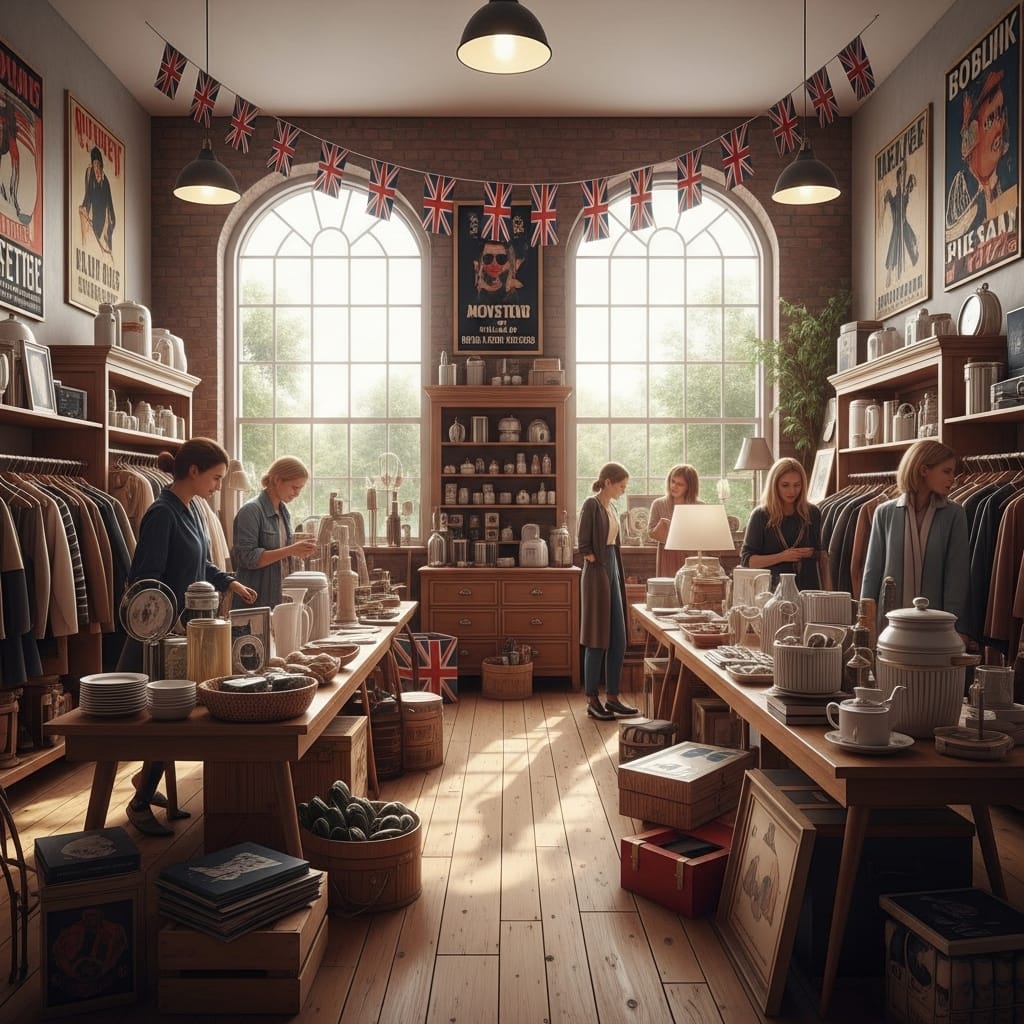
The Secret World of the Saleroom: A Comprehensive Guide to Buying and Selling at Auction in the UK
Step away from the predictable hum of the high street and the endless scroll of online marketplaces. There exists another world of commerce, one steeped in history, theatre, and the tantalising possibility of discovering the extraordinary. This is the world of the British saleroom, a place where the past is palpable, and every object has a story waiting to be told. For the uninitiated, the auction house can seem an intimidating place, a closed-off club for tweed-clad connoisseurs with bottomless pockets. But the reality is far more exciting and accessible. From grand London institutions to charming regional barns, the modern saleroom is a vibrant, democratic space offering a unique and sustainable way to acquire everything from fine art to a new kitchen table.
The air in a saleroom on viewing day crackles with a unique energy. It’s a quiet, respectful buzz of treasure hunters, seasoned dealers, and curious newcomers. Here, you are not merely a consumer; you are a detective. You can pick up a Georgian silver teapot, feel its satisfying weight, and inspect the maker’s mark with a jeweller’s loupe. You can run your hand over the worn patina of an Arts and Crafts oak sideboard, imagining the generations of family meals it has witnessed. This tangible connection to history is something that no flat-pack furniture delivery or digital shopping cart can ever replicate. The auction process is a journey of discovery, and this guide is your map to navigating its thrilling landscape, whether you’re looking to buy a one-of-a-kind piece or sell a cherished heirloom.
A Brief Gavel Through History: The Evolution of the UK Saleroom
The roots of the British auction house run deep, entwined with the nation’s social and economic history. While informal auctions have existed for millennia, the saleroom as we know it began to take shape in the late 17th and early 18th centuries. The London coffee houses, bustling hubs of commerce and conversation, were the crucible for this new form of trade. Entrepreneurs would hire a room, gather a crowd, and sell goods – from ship cargoes to art collections – to the highest bidder. It was in this dynamic environment that the legendary names of the auction world were born. Sotheby’s was founded in 1744, initially as a seller of rare books, while James Christie held his first sale in 1766, quickly establishing a reputation for fine art. These houses professionalised the process, introducing catalogues, viewing days, and the charismatic, authoritative figure of the auctioneer.

Throughout the 19th and 20th centuries, salerooms became integral to the settling of aristocratic estates, dispersing vast collections of art, furniture, and curiosities. This cemented their reputation as places of immense cultural importance, but also contributed to the perception of them as exclusive. However, alongside these grand establishments, a network of smaller, regional auction houses flourished. These were the places where local farmers sold livestock, where solicitors handled house clearances, and where ordinary people could buy and sell the contents of their homes. They became vital parts of the local community, a weekly or monthly event that was as much about social interaction as it was about commerce.
The dawn of the 21st century brought the most significant change of all: the internet. Initially, some feared that online bidding would spell the end for the physical saleroom. The opposite proved to be true. The ability to view catalogues online, leave absentee bids, and even participate in live bidding from anywhere in the world has revolutionised the industry. It has blown the doors of the saleroom wide open, attracting a new, global audience and making it easier than ever for anyone to take part. Today, the modern UK saleroom is a hybrid, blending centuries of tradition with cutting-edge technology, offering a dynamic and truly global marketplace.
The Buyer’s Guide: How to Navigate the Auction Floor with Confidence
The thought of raising a hand or a paddle in a fast-paced auction can be daunting, but with a little preparation, it becomes an exhilarating experience. The key is to do your homework and approach it with a clear strategy.
Finding Your Saleroom
The UK is home to hundreds of auction houses, each with its own character and specialisms. The famous London houses like Christie’s, Sotheby’s, and Bonhams are known for high-value fine art, antiques, and jewellery. Regional powerhouses like Lyon & Turnbull in Scotland or Fellows in Birmingham offer a broad range of quality items. Then there are the countless local salerooms that hold weekly or fortnightly general sales. These are fantastic places to find affordable furniture, ceramics, pictures, and household goods. A simple online search for “auction houses near me” is the best place to start. Most have websites where you can browse upcoming sales and sign up for email alerts.
The Catalogue is Your Bible
Before any sale, the auction house produces a catalogue, which is your essential guide to what’s on offer. This will be available online and sometimes in print. Each item, or “lot,” is given a number and a description. Pay close attention to the details. The description will include dimensions, materials, and any known information about its age or origin. Crucially, it will also feature an “estimate.” This is not a valuation but the auctioneer’s professional opinion of what the lot is likely to fetch. It’s a guide to help you budget. You should also look for notes on the item’s condition. Phrases like “A/F” (as found or all faults), “some damage,” or “restoration” are red flags that warrant a closer look. Most auction houses will also provide a more detailed condition report upon request, which is always worth asking for if you cannot view the item in person.
The Viewing Day: Your Chance to Play Detective
This is arguably the most important part of the buying process. No matter how good the photos are, nothing beats seeing an item in the flesh. Viewing days are typically held for a few days leading up to the auction. This is your opportunity to thoroughly inspect any lots you are interested in. Don’t be shy. Pick things up (carefully!), open drawers, check for chips or cracks on ceramics, look for signs of woodworm in furniture, and examine paintings out of their frames if possible. For furniture, check the stability of joints. For silver, look for hallmarks. This is also your chance to get a feel for the true size and scale of an item, which can be deceptive in photos. It’s on the viewing day that you might spot a hidden gem that others have overlooked or, conversely, notice a fatal flaw that saves you from making a costly mistake.
The Art and Science of Bidding
Once you’ve done your research and set your heart on a lot, it’s time to decide how you’ll bid. You have several options:
- In Person: The traditional and most exciting way. You’ll need to register at the saleroom office before the auction starts, where you’ll be given a paddle with your bidding number on it.
- Absentee Bid (or Commission Bid): If you can’t attend, you can leave a bid with the auction house beforehand. You state the maximum amount you are willing to pay for a lot, and the auctioneer will bid on your behalf up to that limit. It’s a great way to avoid getting carried away in the heat of the moment.
- Telephone Bid: For higher-value lots, you can arrange to bid live over the phone. A member of the saleroom staff will call you just before your lot comes up and will relay the bidding to you, placing bids in the room on your instruction.
- Online Bidding: Most salerooms now offer live online bidding via their own platform or a third-party service. You can watch the auction live and click to bid from your computer or phone. Be aware that this service usually carries an additional fee.
When the auction starts, the auctioneer will move through the catalogue lot by lot. They will typically start the bidding below the low estimate and move up in set increments. To bid in person, simply raise your paddle or hand clearly so the auctioneer can see you. When the bidding stops, the auctioneer will give a final warning and bring the hammer down. If you are the highest bidder, the lot is yours. The most important rule of bidding is to decide your maximum price *before* the auction starts and stick to it. It’s easy to get caught up in a bidding war, so discipline is key.
The Hammer Falls: What Happens Next?
Congratulations, you’ve won your lot! The price the hammer falls at is known as the “hammer price.” However, this isn’t the final amount you will pay. On top of this, you will have to pay the “Buyer’s Premium,” a percentage of the hammer price that goes to the auction house. This is typically around 20-30% plus VAT, so it’s a significant extra cost that you must factor into your maximum bid. Once you’ve paid your invoice, you’ll need to arrange for collection or delivery of your item within a specified timeframe.
The Seller’s Story: Turning Your Treasures into Cash
Selling at auction can be a simple and effective way to achieve the best market price for your items. Whether you’re clearing a house, downsizing, or simply want to sell a single object, the process begins with a valuation.
Most auction houses offer free, no-obligation valuations. You can often get an initial idea by emailing them clear photographs of your item. For larger collections or more significant pieces, they may arrange for a specialist to visit your home. Many also hold regular valuation days where you can bring your items in for assessment. The valuer will give you an auction estimate and advise you on the best sale to place your item in to attract the right buyers.
If you decide to proceed, you will sign a consignment agreement. A crucial part of this is setting the “reserve price.” This is the secret, minimum hammer price at which you are willing to sell the item. If the bidding does not reach the reserve, the item will go unsold. The auction house will then photograph and catalogue your item, and you will be charged a “Seller’s Commission” or “Vendor’s Commission,” which is a percentage of the hammer price, along with any fees for insurance or illustration. After a successful sale, you will receive payment, minus these deductions, typically a few weeks after the auction.
Selling at auction provides transparency and exposes your items to a wide pool of competing buyers, often achieving a far better price than a private sale. It is the saleroom’s expertise in marketing and reaching the right audience that you are paying for, and it can be a highly rewarding process.
The UK saleroom is more than just a place to buy and sell. It is a hub of stories, a bastion of sustainability, and a theatre of human desire. It is a place where you can find genuine craftsmanship, unique design, and a real connection to the past. So next time a sale is on, why not pop in? You don’t have to bid a penny. Just soak up the atmosphere, handle the objects, and witness the drama unfold. You might just find that the world of the saleroom is a world you want to be a part of.







